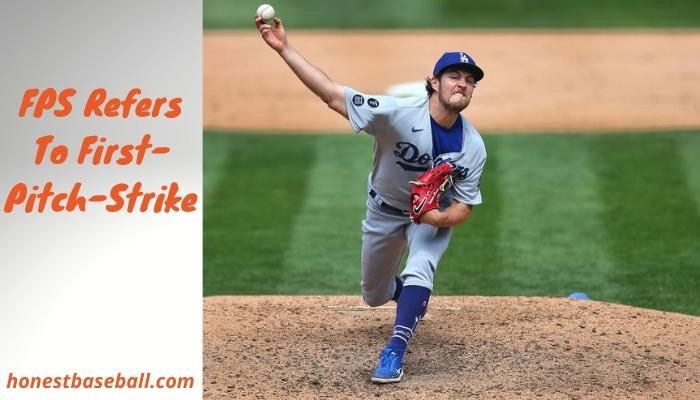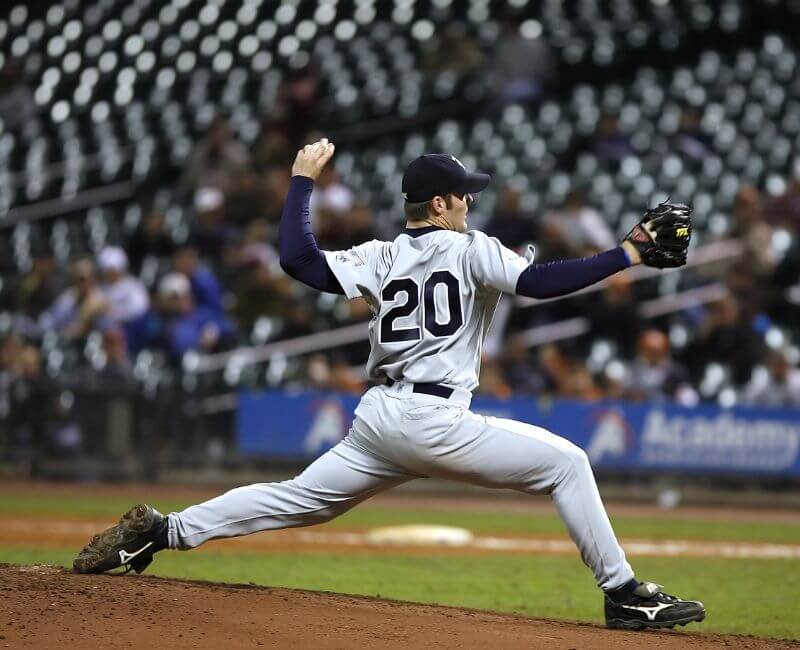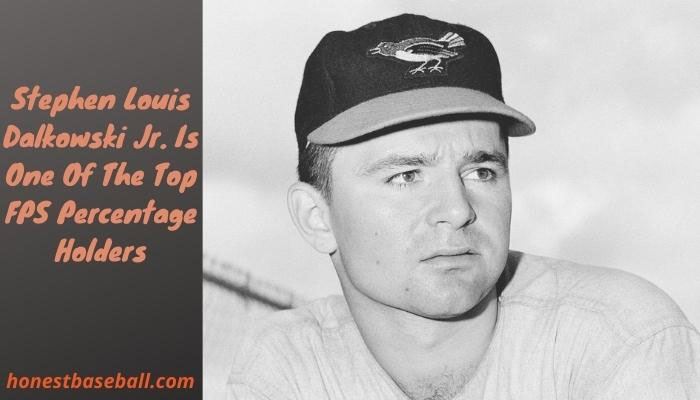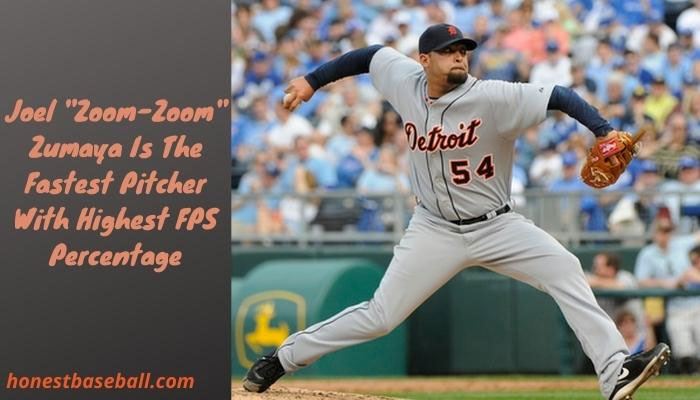First Pitch Strike, or FPS for short, is a term in baseball for when the pitcher throws a strike on the first pitch.
This initial strike can change the whole game, putting them in control. The pitcher’s ability to place a good first pitch is an important skill that’s tracked throughout games.
What is FPS in Baseball?

The term “First Pitch Strike” (FPS) refers to the situation where the initial pitch delivered to a batter during their at-bat is officially called a strike by the umpire.
This is a very important time in a baseball game, as it typically grants the pitcher an advantage in the subsequent sequence of pitches.
According to a study conducted on Major League Baseball (MLB) data, a batter’s average drops significantly after a first-pitch strike.
For instance, in 2018, MLB batters had a .262 average overall. However, after a first-pitch strike, the average plummeted to .199.
On the flip side, if the pitcher fails to achieve FPS and the count is 1-0 (one ball, no strikes), a batter’s average ascends to .271.
How Does FPS Work?
FPS, or First Pitch Strike, is simple to understand. When a batter steps up to the plate, the pitcher tosses the ball.
If the umpire calls it a strike, that’s an FPS.
It means the pitcher has started well. A strike can occur in two ways.
One, the batter swings and misses.
Two, the batter doesn’t swing, but the ball is in the strike zone.
The zone is a space over home plate. It is about the width of the plate and varies in height. But remember, not every first pitch ends up as a strike.
If the batter hits it, or it’s outside the strike zone, it’s not an FPS. A good FPS rate can show a pitcher’s skill. It can also change how the game ends up.

How to Calculate FPS?
Calculating the First Pitch Strike (FPS) percentage is a straightforward process.
It is the ratio of first-pitch strikes thrown by a pitcher to the total number of batters faced. Here’s a step-by-step guide:
- Track the number of batters faced: Take note of every batter that a pitcher faces during the game. This includes any batter who steps up to the plate, regardless of the result of their at-bat.
- Count the number of first-pitch strikes: Keep a tally of how many times the first pitch thrown to a batter is called a strike by the umpire. This includes pitches that the batter swings at and misses, as well as pitches that the batter doesn’t swing at but still lands within the strike zone.
- Calculate the FPS percentage: Divide the number of first-pitch strikes by the total number of batters faced and multiply it by 100 to get the FPS percentage. The formula looks like this: (Number of FPS / Total Number of Batters Faced) * 100.
For example, if a pitcher faces 20 batters and throws a first-pitch strike to 15 of them, their FPS percentage would be (15 / 20) * 100, which equals 75%.
What is a Good FPS in Baseball?
The FPS rate, or First Pitch Strike rate in the MLB is considered to be good if it’s above 60%.
If a pitcher consistently hits this target, they have shown a level of control and effectiveness in their pitching.
According to statistics from the MLB, the average FPS rate among players tends to stay around this area. With some of the best pitchers in the league often hitting high 60s and even low 70s.
For example, Shane Bieber of the Cleveland Indians managed to lead the league with an impressive 68.1% FPS rate in 2020.
Jacob deGrom of the New York Mets boasted a rate of 67.5% in the same year.
When you can see pitchers hitting high rates like these, it usually means better overall performance. This is seen by lower earned run averages as well as higher strikeouts.
Different leagues have different ideas of what a good FPS rate would be. For example, NCAA Division I baseball sees anything between an exceptional 65-70% fitting that mold.
In youth and high school baseball, they’ll see goals as low as 60%. Players in these stages are still developing themselves.
Why is FPS an Important Statistic for Pitchers?
Primarily, it provides a direct measure of a pitcher’s efficiency and control.
FPS sets a pitcher in a dominant position at the very outset of the batter-pitcher confrontation. By placing the batter on the defensive, the pitcher gains more options for their subsequent pitches.
They can experiment with a wider range of pitch types and locations, increasing the likelihood of the batter making a strike out.
A high FPS rate typically leads to fewer pitches per at-bat, which translates into less fatigue for the pitcher. This allows them to stay in the game longer and maintain a high-performance level.
Statistical analysis also supports the importance of FPS. When the count starts 0-1 (a strike as the first pitch), batters’ averages significantly drop.
This puts the pitcher in a superior position, increasing their chances of getting an out and preventing runs.
Consequently, a high FPS rate often correlates with a lower Earned Run Average (ERA), which ultimately contributes to the team’s chances of winning.
How to Improve Your FPS as a Pitcher?
As you improve your first pitch strike (FPS) rate, you’ll notice a huge change in the way you pitch. Here are some tips:
Accuracy: The key to accuracy is practice. Take time to perfect your pitch. If you can consistently throw a well-aimed first pitch, then your FPS rate will definitely get better.
Pitch Variety: Don’t stick to one type of pitch. Learn multiple. The most effective way to use this variety is when it comes to the batter guessing what type of ball you’ll throw at them. In addition, look up different pitching drills to help with accuracy.
The Grip: When holding the ball, make sure you have a firm and comfortable grip on it. Having this alone can make all the difference in how accurate and controlled your pitches are.
Warm Up: Before throwing your first pitch, make sure that you’re properly warmed up. Not only does this help prevent injuries — it also improves performance.
Stay Calm: It’s natural for nerves to happen when you’re standing on the mound, but try and keep calm. You won’t be able to focus if you let those nerves get the best of you.
Study Them: Researching their tendencies can work in your favor when planning your first pitch.
The Most Powerful Pitchers With Best FPS Experience
What do you think about your favorite pitcher when he comes to pitch? You think if he does something exceptional and eye-pleasing. Isn’t it?
Yes, I am pretty sure you love to see your favorite pitcher pitch. By the way, when your favorite pitcher is just out of the batter, the story is different for the batters and their fans.
You might wish them “better luck next time.” By the way, now I am going to introduce the three most powerful pitchers who pitch with lightning speed.
Stephen Louis Dalkowski Jr.
Have you ever thought a Minor League pitcher may be on the top of the fastest pitching list? If not, rethink it.
Stephen Louis Dalkowski Jr., or Steve Dalkowski, was a left-hander. He was never a member of the Major League Baseball team.
Despite this, he was dubbed “White Lightning” because of the lightning-like rapidity with which he could throw lightning.

He was also known by the moniker “Fastest.” And you’ve probably guessed that all of this is in preparation for his lightning-fast throwing. By the way, on the baseball field, he was unpredictable and sometimes aggressive.
However, it’s possible that I’ve failed to indicate his speed range till now. In this throwing, he was able to achieve speeds in excess of 100 mph.
Another terrible detail about him is that he is a heavy drinker. He used to be an alcoholic for most of the time after he retired. However, as was to be anticipated, he suffered a loss of energy, stamina, and professional ability as a result of this circumstance.
Despite the fact that he had forgotten about his professional career, his followers adored him for his remarkable pitching career.
Joel Zumaya
The Detroit Tigers selected Joel Zumaya in the first round of the 2002 draft in the Minor League because of his powerful arm and throwing ability.
He was a good thrower during his high school years and could throw well at his age. Although he began his professional career with a low-A affiliate, he made his first appearance for the West Michigan Whitecaps in 2003.

In 2004, he began playing for the Lakeland Tigers, a High-A affiliate of the Minnesota Twins. However, he received a late-season promotion to the Double-A Erie SeaWolves during that season.
Joel Zumaya was affectionately referred to as “Zoom-Zoom” by his fans because of his unpredictability and lightning-fast pitching.
However, “Zoom-Zoom” began his Major League Baseball career in 2006 with the Detroit Tigers. He was a member of the Detroit Tigers who was known for his versatility.
He was used as a setup pitcher and a middle relief pitcher on occasion. However, he was a fan favorite because of his aggressive demeanor on the mound.
With his pitching velocity, he was able to reach speeds of up to 104.8 mph. You might be a little perplexed by his 13-12 win-loss record over the course of his 171-game career.
However, this does not accurately represent his pitching ability.
Zumaya finished his career with a 3.05 earned run average. However, he was hampered by a number of injuries, which caused his baseball career to be cut short. And tragically, he had to quit in 2011, just aged 27.
Catcher Ivan Rodriguez, on the other hand, claimed Zumaya’s 100 mph throw was the fastest ball he had ever caught.
High-speed throwing increases the probability of getting an FPS percentage more. So, increasing your pitching speed can help you to get an FPS percentage, too. However, our guide on “How to Increase Pitching Velocity By 10 MPH” will surely help you to increase your pitching speed.
Walter Johnson
Walter Johnson, the man who had held the most strikeouts career record for the time from 1927 to 1983. He holds 3,508 strikeouts in his baseball career. He was nicknamed “Barney” and “The Big Train.”

Johnson was not only a baseball player but a baseball team manager. He spent his 21-year baseball career with the Washington Senators. The time was from 1907 to 1927.
On the other hand, he was appointed as the manager of Washington Senators from 1929 to 1932. Later on, he was appointed as the team manager of the Cleveland Indians in 1933, which lasted till 1935.
As a pitcher, he is widely regarded as one of the all-time greats in the history of baseball. He made some such records that need nine decades to be broken.
He was, on the other hand, the only pitcher in baseball history to reach the milestone of 3,000 strikeouts, which was sustained till 1974. On July 22, 1974, Bob Gibson became the second member of the 3,000-strikeout club.
It was only after that that Johnson gained another member of the 3,000 strikeout club.
In addition, Walter Johnson has the most innings played out of the 18 members of the 3,000 strikeouts club.
There were a lot of achievements he did in his baseball career. He led the major league 12 times with strikeouts. And you know, he did that in eight consecutive seasons.
Walter Johnson was the only pitcher who recorded 400 wins and 3,500 strikeouts together. Also, he was one of the “First Five” members of the Baseball Hall of Fame.
Can you define a Pitcher with their FPS statistics?
The First Pitch Strike (FPS) statistic is a crucial barometer of a pitcher’s efficiency and control. But it does not define a pitcher in its entirety.
Yes, pitchers with high FPS rates often demonstrate exceptional command and pitching prowess. It underscores their ability to seize the initiative and manage the pace of the game.
However, baseball is a complex sport, and a pitcher’s overall effectiveness is determined by a myriad of factors beyond just the FPS.
Pitch speed, types of pitches thrown, handling pressure situations, stamina, and resilience to bounce back from poor performances are all aspects that play a vital role in defining a pitcher’s quality.
Hence, while FPS is a highly valuable statistic that often correlates with a pitcher’s success, it is just one piece of the larger puzzle.
It provides insight into the pitcher’s game strategy but does not alone define the entirety of a pitcher’s skill set or their contribution to the team.
Know More on Statistics
What Does WHIP Mean In Baseball
LOB In Baseball: What It Means
What Does RBI Mean In Baseball
What Is WAR (Wins Above Replacement) In Baseball

Hello everyone. My name is Jason Butler, and I live in California, America. I was a professional AAA Minor League Baseball player. I lost my chance of playing MLB for injury issues, but I did not lose my love for baseball. I attended the coaching training program and am now working as a coach in a small school in San Diego.
I always love to share my experience and knowledge if that can help you. Play baseball, and stay fit.
